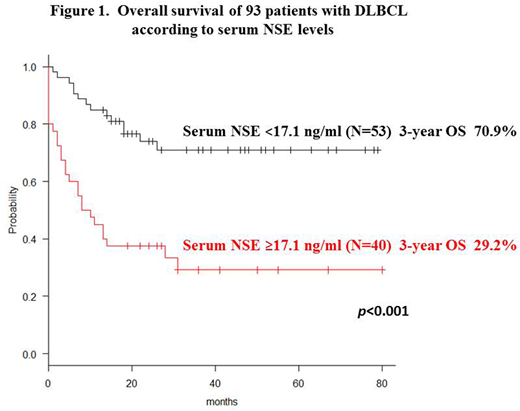Abstract
[Introduction] Neuron-specific enolase (NSE) is the γ-γ or γ-δ dimer isoenzyme of enolase, an acidic protease that promotes the conversion of β-glycerophosphate into dihydroxyacetone phosphate during glycolysis, is mainly found in mature neurons and cells of neuronal origin. Studies of NSE as a tumor marker have primarily focused on patients with small cell lung cancer and neuroblastoma. NSE is not only a useful marker for disease aggressiveness, but also a prognostic factor. Elevated serum NSE expression has been found in 35% of non-neuroendocrine tumors, such as non-small cell lung carcinoma, breast cancer, and multiple myeloma. However, few reports have indicated whether serum NSE levels influence the clinical features and prognosis of malignant lymphoma (ML). In this study, we analyzed the serum NSE levels of patients with newly diagnosed ML and investigated their correlation with clinical outcomes.
[Methods] We retrospectively analyzed 187 patients with ML diagnosed at our institution between 2011 and 2017. The patients included 109 males and 78 females with a median age of 72 years (range 22-93 years). The histological subtypes were; 93 DLBCL, 42 FL, 9 MALT, 7 MCL, 5 BL, 12 PTCL, 12 HL, and others. The study protocol was approved by the Institutional Review Board of Yokohama Municipal Citizen's Hospital, and it was carried out in accordance with the Declaration of Helsinki.
[Results] Median follow-up time was 38 months. The mean serum value of NSE in 187 lymphoma patients was 23.77+/- 36.04 ng/ml. The mean NSE value in 93 DLBCL patients was significantly higher than that in 42 FL patients (26.99+/-27.56 ng/ml versus 13.80+/-6.85 ng/ml, respectively; p=0.003). Among 93 DLBCL patients, the optimal serum NSE cutoff value for predicting 3-year survival was determined by ROC analysis to be 17.1 ng/ml. In DLBCL patients, patients with high serum NSE levels (≥17.1 ng/ml; N=40) had significantly shorter overall survival (OS) than those with low serum NSE levels (<17.1 ng/ml; N=53) (3-year OS, 29.2% versus 70.9%, respectively; p<0.001) (Figure 1). In univariate analysis, parameters having adverse significance for OS were: high serum NSE levels, high serum LDH levels, PS≥2, stage 3-4, and R-IPI poor risk. In multivariate analysis, parameters having independent adverse significance for OS were: high serum NSE levels (≥17.1 ng/ml) (p=0.03, HR 2.04) and PS≥2 (p<0.001, HR 4.82). Among 42 FL patients, patients with high serum NSE levels (N=10) had also shorter OS than those with low serum NSE levels (N=32) (3-year OS, 60.0% versus 85.1%, respectively; p=0.02). The mean NSE value in high-risk FLIPI patients was higher than that in low- or intermediate-risk FLIPI patients (19.36+/-12.02 ng/ml versus 11.89+/-2.44 ng/ml, respectively; p=0.002).
[Conclusion] In the present study we demonstrated that serum NSE levels were elevated in patients with various types of lymphoma. In particular, our data proved that a high serum NSE level is an independent prognostic factor for survival in patients with DLBCL. These results suggest that serum NSE levels at diagnosis may have an important role in malignant lymphoma and also may be a useful prognostic biomarker. Since our results are based on a small-sized analysis, further large prospective studies are warranted to verify this conclusion.
No relevant conflicts of interest to declare.
Author notes
Asterisk with author names denotes non-ASH members.


This feature is available to Subscribers Only
Sign In or Create an Account Close Modal